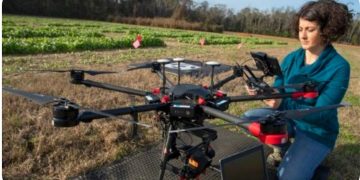Hidden among all the news about COVID-19, hurricanes and the presidential election, you may have missed one of the most important news stories of the year.
In the center of its campus in Gainesville, the University of Florida is building the most powerful artificial intelligence supercomputer in U.S. higher education. This has been huge news at UF, as it will create exciting new opportunities for faculty, students and researchers. But what does it mean for growers and stakeholders in Florida?
Artificial intelligence is the ability of a computer system to recognize patterns, understand language, learn from experience, solve problems and perform complex tasks. In other words, it’s the ability of a machine to think like a human brain, but to do so faster, more accurately and on a massive scale.
If you’re a grower, you care about every plant and every animal on your farm. Given enough time and manpower at your disposal, you would scrutinize every plant and animal, giving each the exact resources needed to grow to their maximum potential. AI allows you to do just that, putting eyes on millions of variables and coordinating vast amounts of data instantly and with pinpoint accuracy.
AI requires a massive amount of computing power. This is why UF’s partnership with NVIDIA and UF alumnus Chris Malachowsky’s gift of the $70 million supercomputer, named HiPerGator, is such an important tool for agriculture.
To give you an idea of the capacity of UF’s new HiPerGator 3.0 computing system, if every UF student doing homework, every faculty member and scientist conducting research, every facility running logistics and every budget office crunching numbers were all using HiPerGator at the same time, it would only tap about 15 percent of its full capacity.
What can it do with other 85 percent? That’s for all of us to decide.
Here at UF/IFAS we’re excited about the possibilities of applying AI to solve everyday problems related to supporting Florida’s agriculture industry, feeding the world’s growing population and using natural resources sustainably. AI has the promise to significantly advance our ability to strengthen food chain systems, develop precision breeding of plants and animals, apply robotics in food and agriculture operations, track the location and spread of pests and pathogens, and collect data on agroecosystem services.
In fact, UF/IFAS has already been applying AI to improved agricultural production for many years. HiPerGator will serve to super-boost these efforts and bring new resources to grow AI’s abilities to help Florida’s growers be more productive and save resources. The following are just a few of the areas where UF/IFAS Extension is helping Florida’s growers apply AI research to their production.
Citrus
Yiannis Ampatzidis and his research team at Southwest Florida REC have developed AI-based software called Agroview to analyze and visualize data collected from UAVs, or drones. Instead of spot checks, UAVs can take images of thousands of individual plants and upload them to cloud-based software that analyzes the data to access plant qualities, quantities and growth factors or impacts. The software has a wide range of applications for Florida’s agriculture, including our iconic citrus industry. Developed to help producers take better care of their crops while also saving money, Agroview is such a revolutionary innovation that it recently won UF’s invention of the year award.
http://blogs.ifas.ufl.edu/news/2020/06/04/cloud-based-technology-helps-farmers-count-citrus-trees/
Peanut
Determining the maturity of peanut seed currently requires shelling the hulls from test samples and making a subjective estimate based on seed color. Now Agronomy Department Chair Diane Rowland and her research team have developed a method using hyperspectral imaging and AI to determine peanut seed quality through the hull, allowing peanut farmers to select mature seeds with far greater accuracy and less expenditure of time and labor.































